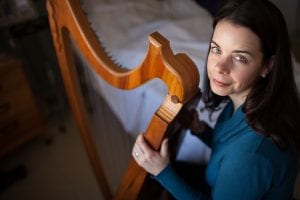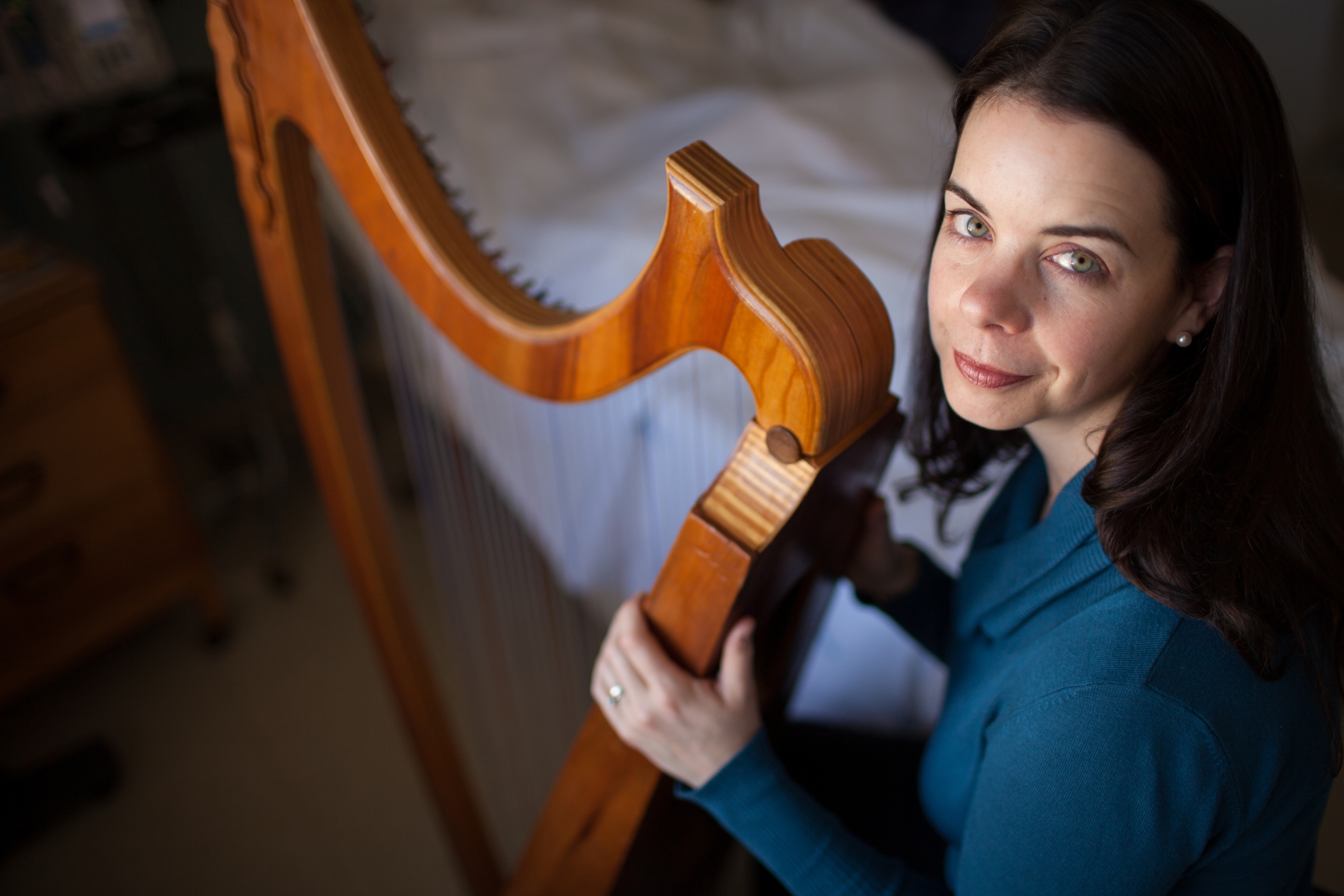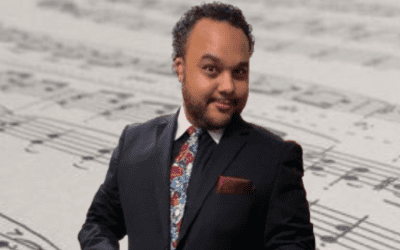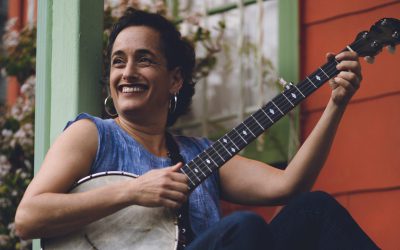It’s not common to think about the performing arts when you think about the end of life. Enter music-thanatology, a little known field where trained, accredited practitioners play harp music and sing in medical settings for terminal patients. Listen as I explore music in medicine with Jennifer to learn how she researched her book and learned just how powerful sound is.
This is the first of a two-part episode of my conversation with her about music that steps in when nurses and staff can no longer offer options for comfort. Music in medicine is a powerful force.
To listen to this episode as a podcast, search for Agile Vocalist wherever you get your podcasts.
Listen to part two of my conversation with Jennifer.

- What is music-thanatology and what are music vigils
- Use cases for music-thanatology for patients and families
- Jennifer Hollis talks about her book, Music at the End of Life: Easing the Pain and Preparing for the Passage

Jennifer built her own harp in 1996. It’s a 31-string Gothic harp and an essential tool for her work making music in medicine.
- Beyond pharmaceuticals; music as medical care
- The business of music-thanatology
- How Jennifer finds purpose in her work
Related links:
More about Jennifer
Jennifer plays “Come by the Hills”
Learn more about Harps of Comfort
Tour Jennifer’s harp by Instagram video
Did you enjoy this? Please share it on your socials, leave me a comment, or subscribe to hear more Agile Vocalist.
Episode transcript
[Spoken intro: “Listen to this next Agile Vocalist blogcast” + music]
Rachel Medanic: Jennifer Hollis is a writer, music-thanatologist and project director for Harps of Comfort, an organization that provides virtual harp and vocal music to isolated COVID-19 patients. Jennifer is the author of Music at the End of Life: Easing the Pain and Preparing the Passage. She’s also a contributor to religion and healing in America. Her essays and articles have appeared in The New York Times, the Washington Post, Harvard Review, and other publications. Jennifer’s poems have won the Crossroads International Contest and The Atlantis Award from the poet’s billow. She has been a certified music-thanatologist offering harp and vocal music to patients at the End of Life in Montana, Oregon, Chicago, and Boston.
From 2006 to 2012, she was president of Music-Thanatology Association International. Stories about her work have appeared on NPR, in the Boston Globe, and several podcasts. She has a degree in child development and a master of divinity from Harvard Divinity School. Once upon a time, she was the assistant director of admissions there. Jennifer lives outside Boston with her family.
I’d like to have you talk a little bit about music-thanatology. What is it, and where does it take you? What types of care does it take you to journey, to find people, who are suffering and/or on their way to death?
Jennifer Hollis: Sure, yes. Music-thanatology is a clinical musical modality. We use live harp and vocal music at the bedside of patients who are dying to support them, to relieve suffering, to support their family members, and also their caregivers. We use the visits that we do we call music vigils and the process we use is called a prescriptive process, so we’re thinking about the ways that the raw materials of music like rhythm and melody and tonality, and timbre can be used in a prescriptive way to help alleviate suffering. That means that minute by minute, in the music vigil, we are attending to the patient and thinking about how the music can help support them and that can take a lot of forms.
I always like to say that when I say that I play for dying patients, I like to be clear that death and dying is a process and we really never know when it’s going to happen. Even experts have a hard time predicting when the actual moment of death will be. I certainly have played for patients who were taking their final breath. I’ve also played for patients who had a serious illness that was going to create a decline over many weeks or months or even years, and the music was supporting that longer and slower process of end-of-life care.
Music-thanatology can be very effective for a number of things, certainly symptom management, things like pain and anxiety, and difficult respirations. It can help support a family that’s grieving and a patient that’s preparing to leave their life. It can create an environment where people can have a little space to reflect and process on what’s happening before them.
Often, we play in really busy medical settings like ICUs where there’s a lot of noise and a lot of confusion and it’s very hard to sleep or get any rest because the medical needs of patients in hospitals are so complex. And a music vigil can be a time for a different kind of space. We play wherever patients are. In the “Before Times,” we played in hospitals and nursing homes and hospice settings. Sometimes a hospice will have an inpatient unit in a hospital, so we just go wherever the patients are.
Rachel: You wrote a book Music at the End of Life: Easing the Pain and Preparing the Passage and that was published in 2010. Can you tell us a little bit about your perspective as an author of that book and how music is perceived in medicine and what you learned?
Jennifer: Sure, yes. This was a really exciting project for me to work on because I had an opportunity to interview my music-thanatology colleagues, but also their colleagues in medical settings. I did somewhere between 50 and 60 interviews of music thanatologists, physicians, nurses, social workers, chaplains, hospice massage therapist, so people who had not only done the work of music-thanatology but also who worked on teams with music thanatologists.
I got to ask them all the questions that I was curious about, as a music- thanatologist, but never really had the opportunity to ask anyone. That was things like, “When are the moments when you call on music-thanatology? What do you think the value is of adding someone with a harp who is going to wheel it through your hospital hallways, what is the value of adding that to your team, and how is it benefiting the patients that you care for or what patient care does it provide?”
I have to admit, when I went into this research project, I expected people to really appreciate the music, and really think that it was a good use of resources to have music in a medical setting. What I did not expect was that they perceived, many of them, not all of them, but many of them perceived music-thanatology as medical care and talked to me about the limits of time that they had in patient care, and also the limits of pharmaceuticals and procedures.
That in end-of-life care, physicians and nurses wanted to be able to spend more time at the bedside. They wanted to be able to linger and care for patients, but they were incredibly busy. They had so many people to see. There was so much time pressure to move through the day in a certain way that they could refer those patients to the music-thanatologists, who they knew would spend 45 minutes, an hour, 90 minutes. Then in many cases, in the medical chart about what they saw, what their observations were, make referrals to the rest of the team, go to IDT meetings and talk about the plan of care.
Most of the people I talked to in most of these environments, the music thanatologists was really integrated into the medical team, so they could offer the kind of care that other staff just weren’t able to. The other thing that people talk to me about were the limits of pharmaceuticals to do the kind of work needed at the end of life, that kind of meaning-making and letting go and resolving emotional pain and all these things that we know are necessary at the end of life. To say thank you and to ask for forgiveness and these many things that Dr. Ira Byock is famous for writing a book on these resolutions that we need at the end of life.
Physicians, nurses are trained to give holistic care and a lot, I wouldn’t even say a lot, but what a lot of them spoke to me about was the limits of what they can offer people, the limits of pharmaceuticals. They’ve treated the pain, the disease process is taking over. They need something else. It was really beautiful to hear reflected in these interviews that a lot of these team members, they come to the end of what they can offer when they are in end-of-life care and it felt so good to them to be able to offer something like music-thanatology.
I always like to say there’s plenty of opportunities to say “no thank you,” if you want to. For people who want it and for people for whom this really resonates, it can provide just a different kind of care than the everyday life of a medical setting and can provide that little bit of space and quiet. It can transform that room into a different kind space to do just that tough work of letting go that comes at the end of life.
Rachel: Can you talk a little bit about the size of the music-thanatology field and how– I’m curious about: how are the more well-funded hospitals more likely to have access? Do you have any hospitals that you work for where there’s a budget for this, kind of talk about the business of music-thanatology.
Jennifer: Yes, sure. I’d be happy to do that. There are less than 100 practitioners of music-thanatology in the world. Music-thanatology exists within a large context of musicians who play in medical settings. There’s an entirely different field, with an education process and a licensing process called music therapy, many people are familiar with it. There are many more music therapists, and they serve many different populations.
There are other kinds of therapeutic musicians, even people who play at the end of life. But music-thanatology has a small niche within that where we only use harp and vocal music, and we only play for patients at the end of life. Like many fields, music-thanatology has unfolded since the ’80s, when the first training programs were opened and when it launched.
Different hospitals and hospices have had a different relationship with it. I would say what I uncovered in my research is that typically, music-thanatologists will begin to introduce music-thanatology to the places where they might like to get a job. Offering a presentation at a team meeting for continuing education, being available to educate team members in hospitals and hospices about what their care can offer. Then, if that institution becomes very interested in that, and begins to see a way in, then, of course, you have to talk about funding. How will this get funded? Different hospitals have done different things.
Sometimes they will hire a music-thanatologist that is also another professional. Perhaps there’s a chaplain that is also a music-thanatologist, so they’re hired in both capacities. They’re two-thirds chaplain, one-third music-thanatologist. In that way, the institution can just begin to see, “Is there a benefit to our patients? Is there something that we see here that we want to commit to? Does music-thanatology reflect the values of the institution? Does it reflect the kind of patient care that we want to offer?”
Then, also, what are we seeing and hearing from patients and families about these music vigils? Are they beneficial, are they transformative? In that way, over time, an institution can just begin to engage with the field and start to think, “Okay, do we want to dedicate some fundraising or some philanthropy money for this? Do we want to apply for grants? Do we want to simply dedicate a salary to this position, because we value what it offers so much?” Different institutions do it in different ways.
Jennifer: I’ve been hired by a hospital that had grant funding for music, and just, it was a lovely synchronicity that I met them right at that time. I’ve also been hired by a hospice that had a music-thanatology job, where they posted-
Rachel: Wow.
Jennifer: -to fill it, and I sent my resume, and they hired me. I think as it moves into the world, depending on where you live, and how it is you want to pioneer different people do it in different ways.
Rachel: I used to volunteer at our local shelter, and sometimes work with “the cats in the back” who are not up for adoption, who were ill or were deemed not adoptable. That institution, the kill rate was very low, and still very low for cats. There were some that I worked with at the end of life. I noticed that in a moment or two of just interacting with them through their cage, they would come alive, they would blossom. I would love to use that as a lead-in, what calls you back to this work? How responsive or not are the people that you play for? How do you know you’re making an impact?
Jennifer: That’s such a good question because there’s a wide range of things that I see in front of me. I think I would say, over the time I’ve been doing this, what happens probably the most commonly is everybody falls asleep. It’s just so exhausting to be in these settings. I think it takes a little bit of the pressure off to have someone show up with an instrument and not exactly make themselves the center of attention, but there’s a little something else going on than the conversation, or the attending to the patient.
A very typical music vigil for me is coming into the room, speaking with everyone, tuning the harp in the hall, beginning to play, and then watching as the patient just begins to relax and soften, the face relaxes, if their hands are a little clenched, they unclench a little bit. Loved ones who are sitting on the edge of their chair in that hospital rooms are watching everything all the time, just to lean back and lean back, and hopefully, calm and rest. I tend to tell people, because, in everyday life, we do not have a lot of experiences of someone coming into our personal space with an instrument gazing at us and playing music along with our breaths.
Most people happen to have a loved one, or a parent or a sweetheart who plays an instrument. Most of us have never seen or heard this. I do tell people, this is not a concert, you do not have to behave yourself. It is okay if you fall asleep, it’s okay if you need to get up and leave. We’re just going to be in this together for a little while, and I am going to check-in in case you need something, and we’re going to try it out and see how it goes. Hopefully, that gives people a sense that they’re not going to be stuck with an hour of harp music, they can just relax a little bit and see, and then I’m going to check-in.
Rachel: What calls you personally back? You talked about the difference that you’re making, but why do you keep doing this work?
Jennifer: Yes. It is hard. I do see people who are really suffering. I see sometimes I can just tap into the humanity of my own mortality and the mortality of the people I love, but music can really help. I think some of the suffering that comes with those moments is that we feel so helpless. We don’t know what to do, we don’t know what to say, we don’t know how to say goodbye in a good way. A lot of us don’t have a lot of experience with that, we might not have ritual, or culture, or practices to call on, we don’t know what to do.
In some ways, music can really mediate that. It can really hold and cradle people while they are trying to be together in a good way. I feel very, very grateful to have something useful to do. I feel very grateful that most of the time if someone has had music-thanatology explained to them and said, “Yes,” I can be confident that it will be effective. I keep coming back to it because I keep observing its efficacy, and just the beauty of sharing music with people. I’ll also say the other thing I come back for is how exquisite and tender the people that I witness are with each other. I started this as a very young adult. I was 22 when I started my training, and I’m 48 now.
All the way through my early adulthood into middle age, I have had just the opportunity to witness strangers tending to each other in this beautiful way where they’re holding hands, or they’re trying to say the right thing, or they’re moving close to the bed, or they’re laying their cheek on the blanket to be close to their loved one, or they’re telling stories. I’ve had all this training. I’ve had music-thanatology training. I went to Divinity School. I’ve been thinking when talking with my colleagues for years, and years, and years.
I assume that most of the families I visit with are just improvising. They’re improvising these moments together, trying to say goodbye in the right way, trying to end on the right note. That’s a gift to me to just watch just how much people love each other, and how vulnerable they’re willing to be, and how hard they’re working even though they’re frightened, and even though they’re grieving, how hard they’re working to be there and grieve and weep in front of each other and say the right word. Anyway. Yes. Also, it’s just a personal deep education for me about what does it mean to be a living creature.
[Spoken outro: “That was inspiring. Be sure to listen again soon + music]




